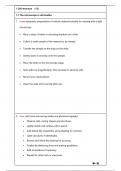Summary
Summary 20k words!!! AS Biology Syllabus Analysis|2024 Newest!
This AS CIE Biology syllabus analysis offers a comprehensive, step-by-step explanation of each syllabus point, directly mapped to the official curriculum. Each topic is thoroughly explained, providing students with clear insights and helping them understand key concepts in a structured manner. This...
[Show more]



